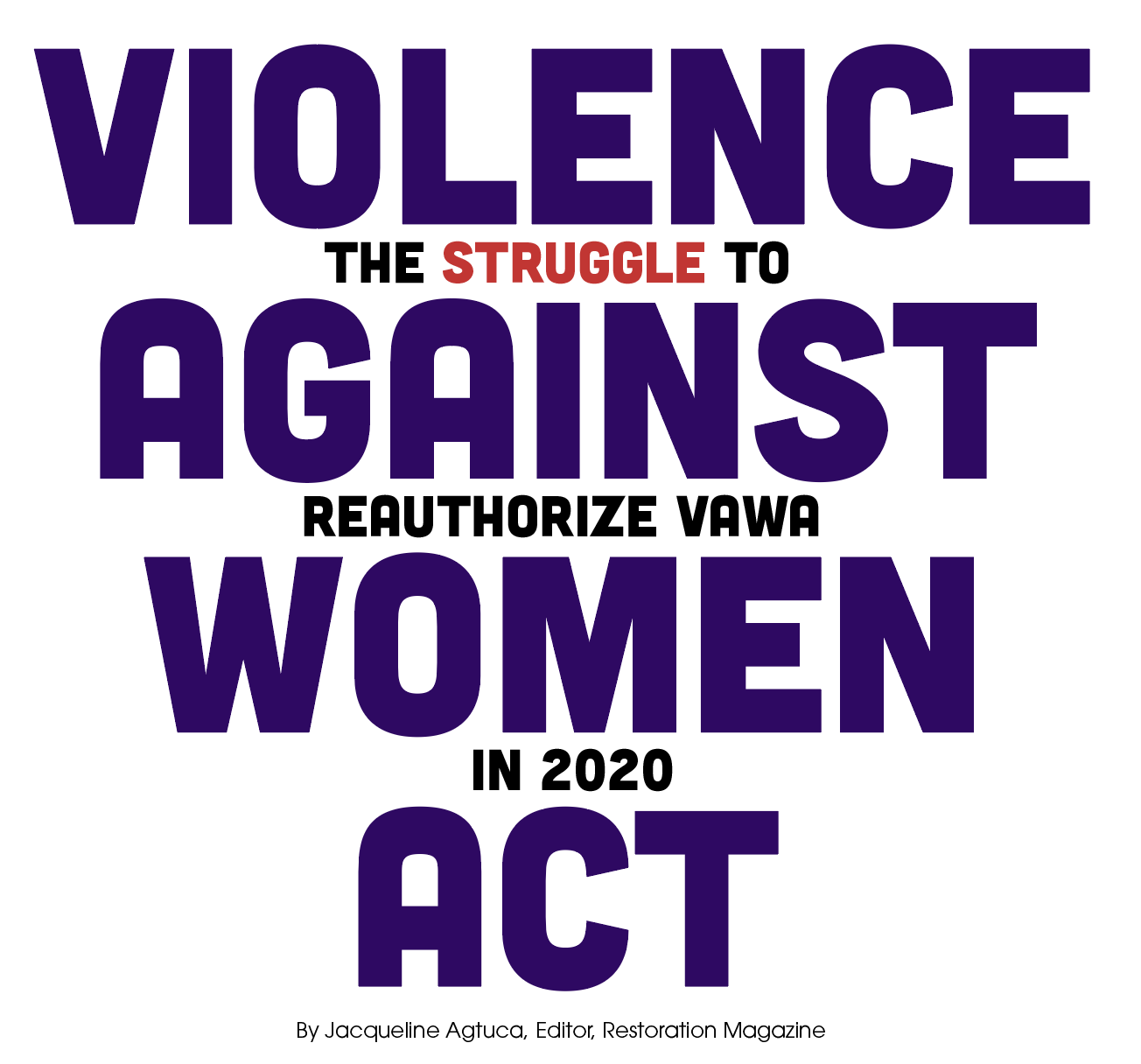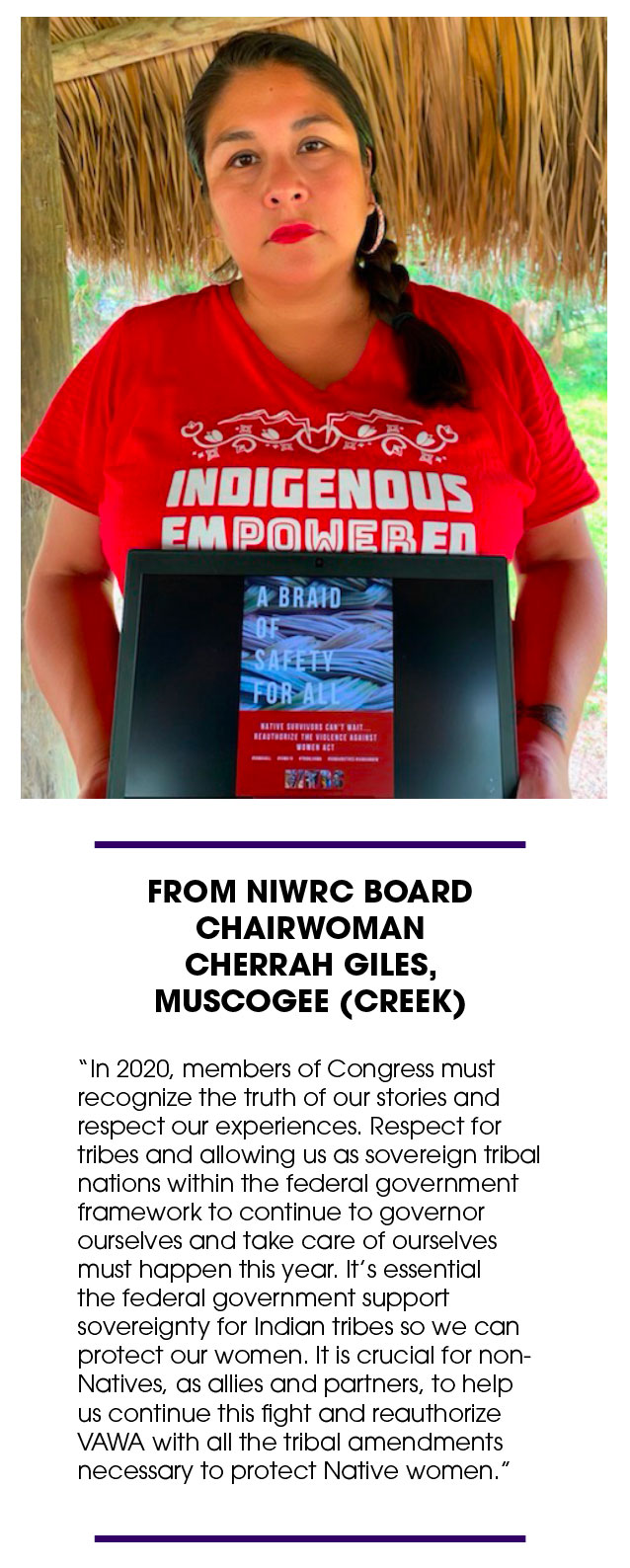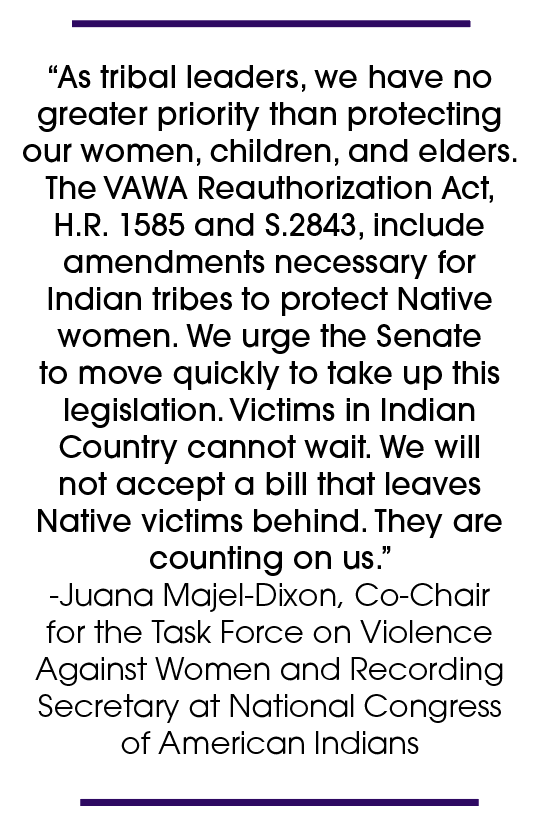Violence Against Women Act: The Struggle to Reauthorize VAWA in 2020

In 2013, the movement for safety won a historic victory in the partial return of jurisdiction to Indian tribes over non-Indians committing domestic violence. While many said this would “never happen” tribal women who were survivors of such violence understood the dangers perpetrated by non-Indians. These sisters stepped forward to testify at Congressional hearings, speak to the media, and, share their stories where needed.
It is important to remember the calls for this reform were raised during prior reauthorizations of VAWA in 2000 and then again in 2005. The earlier efforts failed. Why? In short, the national movement, public awareness, and Congressional leadership were not strong enough to win the votes needed. The misconceptions and mistruths about Native women and tribal justice dominated Congress.
VAWA originally passed in 1995, and then in 2000, with strong bipartisan support. In 2005, the creation of the tribal title faced some opposition but also passed without delays. Reauthorization of VAWA in 2013, however, was a battle. Members of Congress opposed strengthening tribal sovereignty and were relentless—until outvoted. As we begin 2020 and a new decade, the movement faces similar opposition to including lifesaving tribal reforms under VAWA in the U.S Senate. Voids in VAWA 2013 Tribal Jurisdiction
Voids in VAWA 2013 Tribal Jurisdiction
Congress, in 2013, unfortunately, limited the return of tribal jurisdiction over non-Indians to only three domestic violence crimes—domestic violence, dating violence, and violation of an order of protection. In March of 2018, NCAI released a Five-Year Report on VAWA 2013’s Special Domestic Violence Criminal Jurisdiction.1 This Report summarizes the implementation of VAWA 2013’s tribal jurisdiction over non-Indians. It analyzes its impacts in the first 5 years of enactment. The Report is a strong statement that VAWA 2013 is a success, holding criminals accountable and protecting Native women. It is also a statement of the tremendous void that Congress allows to continue by non-Natives who are committing sexual assault, trafficking, and crimes against children and justice personnel responding to domestic violence.
Indian tribes implementing SDVCJ report many of the offenders prosecuted had a significant number of tribal police contacts prior to implementation and had been menacing their victims and straining the tribes’ law enforcement resources. The Tulalip Tribes, for example, has reported that their 17 SDVCJ defendants had a total of 171 contacts with tribal police in the years prior to SDVCJ implementation and their ultimate arrests. The implementing tribes reported the 85 defendants accounted for 378 prior contacts with tribal police before their tribe implemented special domestic violence criminal jurisdiction over non-Indians.
The Tulalip Indian Tribes shared one case example of a non-Indian defendant with 19 prior contacts with tribal police. The case involved an Indian woman who was assaulted and raped by the non-Indian father of her children. “The couple’s 8-year old son disclosed in his statement to police that he was “punched in the face” by his father. This incident, the latest in a long history of abuse, resulted in charges of Assault in the First Degree Domestic Violence and Rape Domestic Violence, but the defendant was not immediately apprehended. Based on the conduct alleged, the victim petitioned for a protection order, which was granted. Prior to defendant’s arraignment on the violent crimes, he was served with, and twice violated, the Protection Order. At the scene of these violations, the defendant was taken into custody. The defendant had nineteen contacts with Tulalip Police prior to these incidents. However, after the implementation of SDVCJ, the defendant was finally held accountable for his crimes. The defendant served a significant jail sentence and is now supervised by Tulalip Probation. He is getting the treatment he needs. The victim and her children were finally able to make a life for themselves away from the violence and abuse.”
This is but one of many examples of the success of the return of tribal jurisdiction over non-Indian abusers. The VAWA 2013 amendment has made a tremendous difference in the lives of victims of domestic violence. Before VAWA, tribal police could only give an abuse victim “a head start” to flee the scene. “In 2014, a non-Indian man attacked his Indian wife in a public parking lot of a gas station. During the assault in the car, he also bit her. When she ran out of the car and rushed into a women’s restroom to seek shelter, he followed her and continued to assault her. The police were called, and tribal and state officers arrived at the scene. In any other case, the man would have been arrested and charged. However, because the assault took place on the Sisseton-Wahpeton Oyate’s reservation land and the defendant was a non-Indian, only the federal government had jurisdiction. So, the tribal and state police who responded did the best they could do. They held the man in custody and painfully told the woman all they could do is try to ‘give her a head start.’” The Sisseton-Wahpeton Indian Tribe is now implementing SDVCJ. Still, for many reasons, such as the lack of resources, the vast major of other Indian tribes are not.
Why Tribal Jurisdiction Under VAWA Must be Expanded in 2020
Passed by the House of Representatives, the VAWA Reauthorization Act, H.R. 1585, includes the expansion of tribal jurisdiction over non-Indians based on the needs of victims, including specific crimes involving children and elders, sexual violence, stalking, sex trafficking, obstruction of justice, and assaults against law enforcement and corrections personnel. Unfortunately, the U.S. Senate has yet to pass a companion bill to reauthorize VAWA. The current lack of tribal jurisdiction over non-Indian offenders emboldens criminals because they face no consequences for violent crimes committed on tribal lands. If Congress continues to stall and show their lack of concern about the safety and well-being of Native women and children, they fail to fully understand that allowing criminals to commit crimes with impunity only raises the threat to all women and children. There are many examples of how the narrow restrictions of the VAWA 2013 SDVCJ limit the protection tribal law can provide victims of domestic violence, sexual assault, trafficking, and other crimes. In the following case reported in the NCAI Five-Year Report, a child sexual predator who evaded tribal prosecution was subsequently arrested by the county for raping a young girl.
There are many examples of how the narrow restrictions of the VAWA 2013 SDVCJ limit the protection tribal law can provide victims of domestic violence, sexual assault, trafficking, and other crimes. In the following case reported in the NCAI Five-Year Report, a child sexual predator who evaded tribal prosecution was subsequently arrested by the county for raping a young girl.
A non-Native man with criminal convictions moved to the Sault Ste. Marie Reservation. He entered into an intimate relationship with a tribal member. He then began making unwanted sexual advances on his girlfriend’s 16-year-old daughter. He sent inappropriate texts to the daughter and would stand outside the windows of their home. On one occasion he groped the daughter and then told her she could not tell anyone about it. The tribe charged the defendant with domestic abuse, attempting to characterize his actions toward the daughter as tied to the relationship with the mother and thus within special domestic violence jurisdiction of the tribe, but the tribal judge dismissed the case as beyond the tribal court’s jurisdiction.
“Four months later, he was arrested and charged by city police with three counts of criminal sexual conduct, one count of attempted criminal sexual conduct, one count of child sexually abusive activity, one count of using a computer to commit a crime, and one count of using a computer network to commit a crime. The alleged incident involves a barely 14-year-old girl who was a tribal member and resided on the Sault Ste. Marie Reservation. The defendant allegedly contacted her online and then kidnapped and held her in an off-reservation motel, repeatedly raping her over the course of 12 hours. The defendant pled not guilty, and the case is currently pending in state court.”
“Had our tribe had jurisdiction to maintain court authority over the alleged non-Native perpetrator for the first incident, this second act of violence may have been prevented,” said Jami Moran, Director of the Sault Ste. Marie Tribe of Chippewa Indians Advocacy Resource Center. “This child’s life will never be the same.”
1. http://www.ncai.org/resources/ncai-publications/SDVCJ_5_Year_Report.pdf





